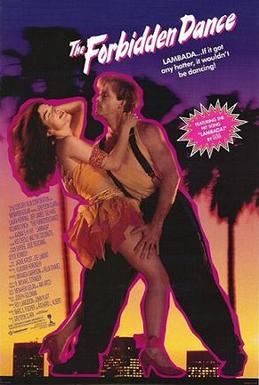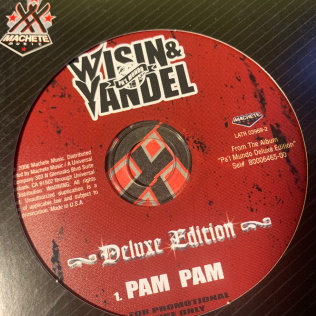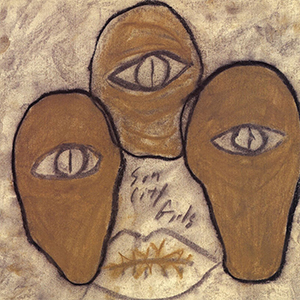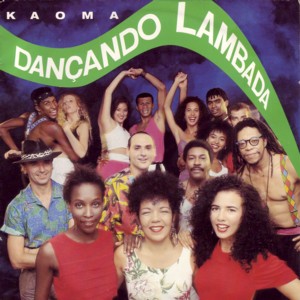The music of Bolivia has a long history. Out of all the Andean countries, Bolivia remains perhaps the most culturally linked to the indigenous peoples.

Lambada is a dance from the state of Pará in Brazil. The dance briefly became internationally popular in the 1980s, especially in the Philippines, Latin America and Caribbean countries. It has adopted aspects of dances such as maxixe, carimbó, forró, salsa and merengue.

Los Kjarkas is a Bolivian band from the Capinota province in the department of Cochabamba, and one of the most popular Andean folk music bands in the country's history. Among the styles they play are Saya, tuntuna, huayno, and carnavales. The instruments they use include the charango, quena, zampoña, ronroco, guitar, and bombo.

Wilkins is a Puerto Rican pop music singer and composer.
Kaoma was a French-Brazilian band formed in January 1989. by French producers Jean Georgakarakos and Olivier Lorsac to promote the song "Lambada". Loalwa Braz was hired to sing lead vocals, other musicians were Chyco Dru (bass), Jacky Arconte (guitar), Jean-Claude Bonaventure (keyboard), Michel Abihssira and Fania. Dru is from Martinique, Arconte from Guadeloupe, and Braz from Brazil.

The Forbidden Dance is a 1990 drama film starring former Miss USA Laura Harring. Made to cash in on the Lambada dance craze by Menahem Golan's 21st Century Film Corporation, it opened on the same day as a similarly themed film, Lambada, produced by Golan's former company Cannon Films and his cousin, Yoram Globus.

Álvaro José Arroyo González was a Colombian salsa and tropical music singer, composer and songwriter. He is considered one of the greatest performers of Caribbean and salsa music in his country and across Latin America. In 2018 Billboard counted Arroyo's song "La Rebelión" as one of the "15 Best Salsa Songs Ever".

"Pam Pam" is a single by Wisin & Yandel from the deluxe edition of their fifth studio album Pa'l Mundo. The song reached big recognition in many Spanish-speaking countries and among Latin community in the United States.

Loalwa Braz Vieira was a Brazilian singer, best known for providing the lead vocals for the French-Brazilian recording act Kaoma for their 1989 cover of the hit "Llorando se fue", later renamed as "Lambada". She was fluent in four languages, and recorded songs in her native Portuguese, as well as in Spanish, French and English.

"Lambada", also known as "Chorando Se Foi (Lambada)", or "Llorando Se Fue (Lambada)" (both meaning "crying, he/she went away" in Portuguese and Spanish, respectively), is a song by French-Brazilian pop group Kaoma. It features guest vocals by Brazilian vocalist Loalwa Braz and was released as the first single from Kaoma's 1989 debut album, Worldbeat. The accompanying music video, filmed in June 1989 in Cocos beach in the city of Trancoso, in the Brazilian state of Bahia, featured the Brazilian child duo Chico & Roberta.

Torch of the Mystics is the fourth studio album by American experimental rock band Sun City Girls. The 1990 LP cover released on Majora differs from the 1993 CD reissue by Tupelo.

"Dançando Lambada" is a song by French-Brazilian group Kaoma with the Brazilian vocalist Loalwa Braz. It was the second single from Kaoma's debut album Worldbeat and followed the smash worldwide hit "Lambada". Released in October 1989, it achieved success, peaking at number four in France, number six in Switzerland and number 11 in Ireland, but was unable to duplicate the success of the band's previous hit single. A dub version of "Lambada" was available on the 12" and CD maxi.

Worldbeat is the debut album by Kaoma, released in 1989. It provided three hit singles, two of them achieving success worldwide: "Lambada", "Dançando Lambada" and "Mélodie d'amour". The album is composed of songs in Portuguese, Spanish and English. It was ranked in the top 25 in Switzerland, Germany, Norway, Australia and Austria. It topped the Billboard Latin Pop in the U.S.

"Baila Esta Cumbia" is a song recorded by American Tejano singer Selena for her second studio album, Ven Conmigo (1990). It was released as the second single by EMI Latin on August 28, 1990, behind "Ya Ves". It was composed by her brother–producer A.B. Quintanilla, and Selena y Los Dinos backup dancer, Pete Astudillo. The recording is an up-tempo Mexican cumbia song. It was well received by music critics who enjoyed its cumbia-feel and rhythm.
The discography of Mexican-American cumbia group Los Kumbia Kings consists of four studio albums, one live album, seven compilation albums, two remix albums, three video albums, twenty-two singles and twenty-one music videos.

"Taboo" is the second single from Don Omar's collaborative album Meet the Orphans released on January 24, 2011 through Universal Latino. The song is re-adapted version from Los Kjarkas's song "Llorando se fue" most commonly known for its use in Kaoma's 1989 hit single "Lambada" fused with Latin beats. The song peaked at number one on the Billboard Latin Songs, becoming his third number one single on the chart.

Bareto is a music group from Peru, famous for making their own versions of classic Peruvian cumbia songs.

Bailão do Ruivão is the third live album by Brazilian band Nando Reis e os Infernais. It is mostly consisted of cover songs. The show was recorded after two months of essays and is composed of Brazilian and international songs selected by Nando, apart from some of his own discography. The song "Could You Be Loved" was performed with Zafenate, the band of Reis' son Theodoro.

Cumbia is a folkloric genre and dance from Colombia.
This article includes an overview of the major events and trends in Latin music in the 2020s, namely in Ibero-America. This includes the rise and fall of various subgenres in Latin music from 2020 to 2029.
















